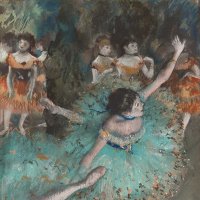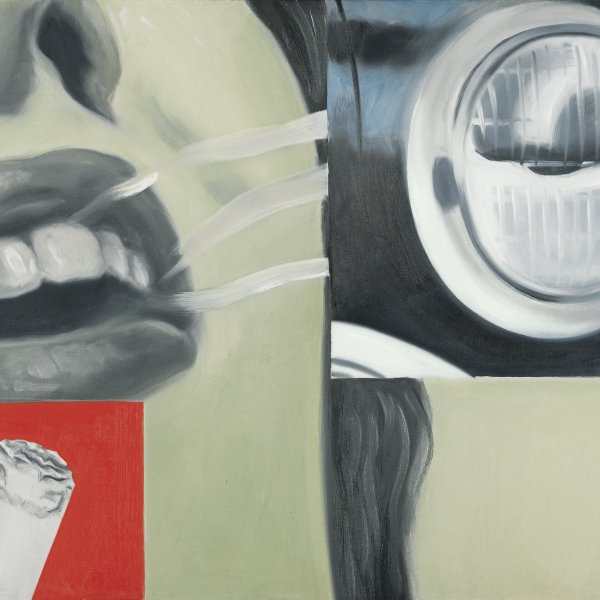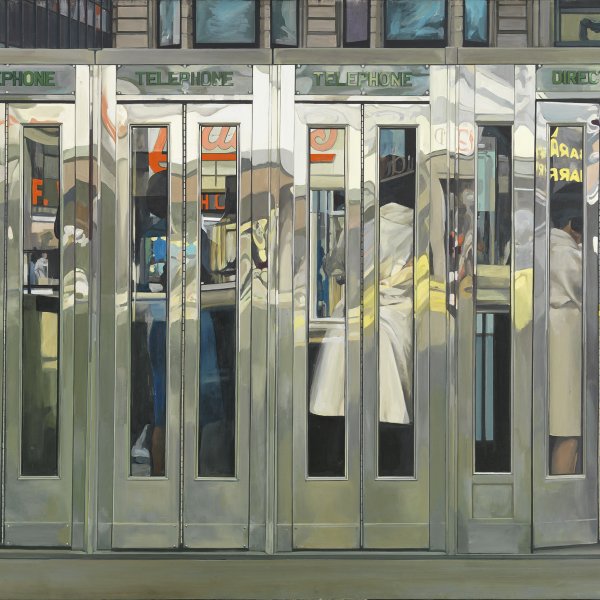Moon over Alabama
1963
Oil on canvas.
204 x 127.7 cm
Museo Nacional Thyssen-Bornemisza, Madrid
Inv. no.
649
(1974.33
)
ROOM 52
Level 1
Permanent Collection
When Richard Lindner arrived in New York in 1941 having spent several years in the French capital, where he found refuge after fleeing Germany in 1933, he gradually retired from his profession as an illustrator and turned his attention to painting instead. His unmistakeable pictorial style, resulting from a laborious process that Werner Spies aptly described as “mental collage, ” was further shaped by a web of different influences. His works, which are inspired by the urban setting of New York or by American mass culture, display the mark of the social satire of George Grosz, the formal simplification of Oskar Schlemmer’s automata and the monumental mechanised figures of Fernand Léger. His backgrounds of abstract forms and typographic phrases recall the aesthetics of poster art and the world of advertising; the psychological associations between the objects and his human figures are reminiscent of Surrealism; the formal decomposition is borrowed from Cubism; and, lastly, his pictorial language and bright, colourful palette link him to Pop Art, of which he is considered to be a forerunner. However, underlying all these affinities and multiple references to the past is an unsettling, original style of painting replete with hidden meanings that make Richard Lindner a unique artist who is difficult to classify. His enigmatic pictorial world, imbued with autobiographical meanings, erotic connotations and literary references, is the result of a perfect symbiosis between the environment of the great American metropolis and the cultural background of early twentieth-century Europe, to which the artist owes his intellectual grounding.
Moon over Alabama, executed in 1963, belongs to the artist’s mature period. The sight of the modern city, which provided the painter with an inexhaustible source of inspiration, is captured in this street scene consisting of a robotised image of two passers-by. Depicted in profile in monumental proportions, they occupy much of the composition, set against a geometric background of powerful, flat colours. The female figure stands out in the foreground and largely conceals the body of the man, who is positioned behind her, further into the background. Whereas the man is dark skinned, the mannequin-woman, portrayed as a contemporary goddess with exaggerated, curvaceous female forms that add to her erotic connotations, has a whitish face that is small in proportion to the volume of her body, with enlarged eyes and overly voluminous lips that give it the appearance of a mask. As on other occasions, the artist uses this modern Amazon to satirise sexual habits or as a mordant criticism of the dehumanisation and solitude of modern life.
The title of the painting is taken from the chorus of a song from Bertolt Brecht and Kurt Weill’s satirical opera Rise and Fall of the City of Mahagonny, written in 1930, of which The Doors recorded a version in their first album of 1967: “Oh, moon of Alabama / We now must say goodbye.” In addition Lindner introduces a contemporary twist to this parable of the moral decomposition of the Weimar society, as in 1963 the state of Alabama had become the main focus of the civil rights movement following the governor of the state’s attempt to prohibit two black students entering the university. As Judith Zilczer has pointed out, Lindner, who backed this movement, provides a visual metaphor of the racial conflicts in this painting through the incomprehension conveyed by these two passers-by of different races who walk in opposite directions, symbolising the distance between them and the tragedy this enmity signifies.
Paloma Alarcó
Moon over Alabama, executed in 1963, belongs to the artist’s mature period. The sight of the modern city, which provided the painter with an inexhaustible source of inspiration, is captured in this street scene consisting of a robotised image of two passers-by. Depicted in profile in monumental proportions, they occupy much of the composition, set against a geometric background of powerful, flat colours. The female figure stands out in the foreground and largely conceals the body of the man, who is positioned behind her, further into the background. Whereas the man is dark skinned, the mannequin-woman, portrayed as a contemporary goddess with exaggerated, curvaceous female forms that add to her erotic connotations, has a whitish face that is small in proportion to the volume of her body, with enlarged eyes and overly voluminous lips that give it the appearance of a mask. As on other occasions, the artist uses this modern Amazon to satirise sexual habits or as a mordant criticism of the dehumanisation and solitude of modern life.
The title of the painting is taken from the chorus of a song from Bertolt Brecht and Kurt Weill’s satirical opera Rise and Fall of the City of Mahagonny, written in 1930, of which The Doors recorded a version in their first album of 1967: “Oh, moon of Alabama / We now must say goodbye.” In addition Lindner introduces a contemporary twist to this parable of the moral decomposition of the Weimar society, as in 1963 the state of Alabama had become the main focus of the civil rights movement following the governor of the state’s attempt to prohibit two black students entering the university. As Judith Zilczer has pointed out, Lindner, who backed this movement, provides a visual metaphor of the racial conflicts in this painting through the incomprehension conveyed by these two passers-by of different races who walk in opposite directions, symbolising the distance between them and the tragedy this enmity signifies.
Paloma Alarcó
Emotions through art
This artwork is part of a study we conducted to analyze people's emotional responses when observing 125 pieces from the museum.
Joy: 48.2%
Disgust: 0%
Contempt: 1.77%
Anger: 18.85%
Fear: 7.1%
Surprise: 6.06%
Sadness: 18.03%










